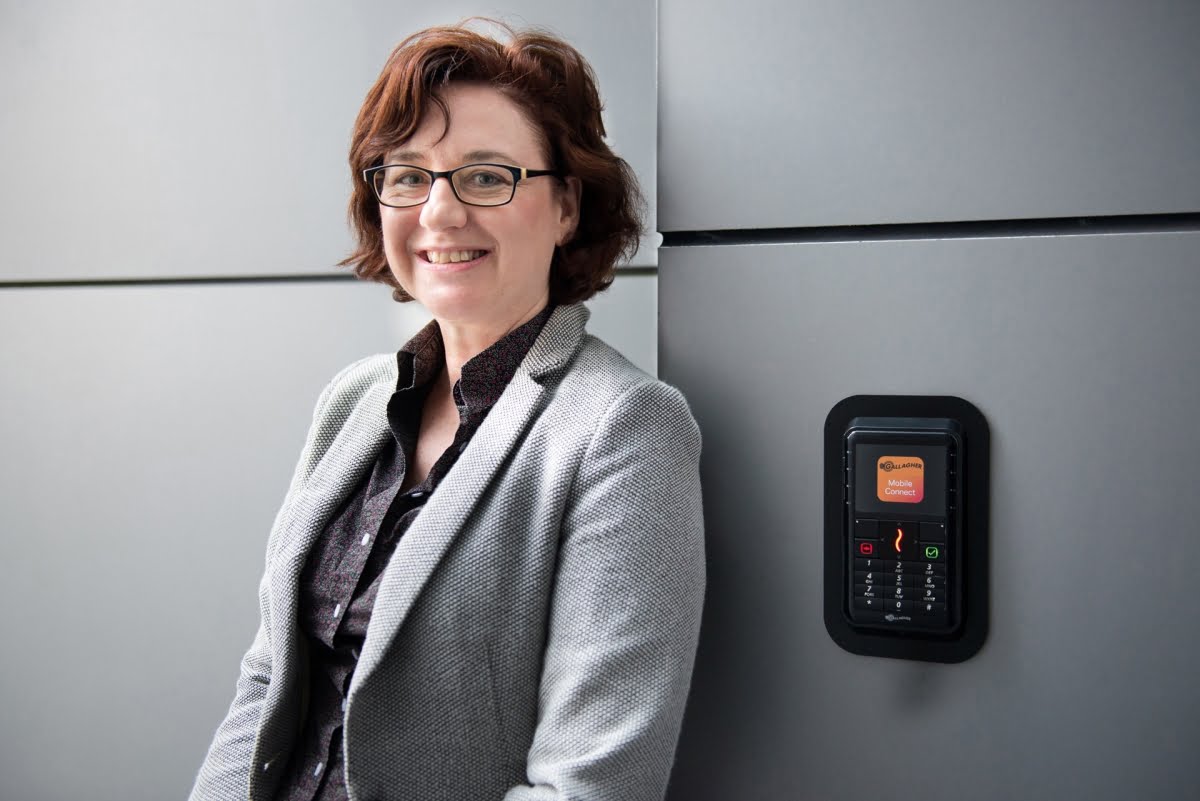Not long ago the complexities of installing access control meant it was an area of business closed to installers with less experience. Times have now changed and careful techs who want to branch out are now supported by a range of solutions that combined simplicity of installation with considerable expansion.
SOMETHING it’s easy to forget when it comes to access control is the lateral nature of the beast. Because solutions are modular, they are constrained only by the capacity of management solutions and the intrepidity of installers. What this means for installation teams making the jump into access is that they can start easy and go hard.
According to Chris Fitzpatrick of CS Technologies, access control is certainly now open to dedicated alarm installers thanks to simplification of installation, setup and commissioning processes.
“A lot of smaller systems can be supplied with certain default information such as 24-hour access, several pre-set time zones, including access times per day, days of the week, etc,” Fitzpatrick says. “This means that to some considerable extent, access control can be almost matter of plug and play.”

Fitzpatrick says there are a number of key things installers should bear in mind when installing an access control solution to ensure core operational requirements are met,
“Typically, the access control system either works with the existing alarm system or is fully integrated with the alarm system,” he explains. “Most access control systems now have full integration, so it is relatively easy to design an integrated system that can provide access control, alarm isolation, both partial or full, and have corridors through the system if required where the alarm system is isolated for a period to allow access to a tenant’s location such as self-storage or lift security in a multistorey building. Getting this integration right is vital for many customers.
“The greatest challenge for access control is the locking and unlocking of the door/doors. This depends on the type and makeup of the doors/doors. This is by far the most challenging aspect of supplying and installing the access control system. Is the door to be alarmed for forced door or door open too long? is the door automatic, is the door in the path of exit for the fire system and needs a fire trip to unlock in the event of a fire alarm?”
“You need to get the type of locking device correct in relation to the door and the health and safety aspect of allowing free exit for users in the event of a fire or other emergency. And in some cases, the health and safety considerations will override the security aspect – for instance, allowing people to leave lift lobbies in the event of a fire alarm and having to install break glass switches in the lobby that override the access control to allow access to fire stairs.”
When it comes to selecting Weigand, RS-485, IP, or some combination of these controller-reader comms technologies, Fitzpatrick says this should be governed by the requirements of the application.
“Any quality access control system should be a fully distributed system with the controller retaining the full programmed memory for the group of doors it is controlling, for instance, names, credentials, time zones, current time and a reasonable capacity for transaction logs,” he says. “Any of these methods is fine as the only need to communicate with the controller would be to download transactions or add or delete user information.”
It’s often argued that the cost of access control per door has decreased significantly over the past 5 years but Fitzpatrick is not convinced.
“Many manufactures would argue yes, but the actual per door cost greatly depends on whether you are looking at the hardware cost or the fully installed cost i.e. cost of the locking device, installing the locking device, the controller and power supply and battery back,” he explains. “Also, this depends on the type of control equipment used. If the non-fully distributed controllers are used then yes, the cost for control equipment is cheaper, but if comms is lost the door access is useless.”
When selecting an access control solution, what should integrators be looking for?
“I would be looking for the ability to handle integration of lifts and some automation, as well as access control and intrusion, along with easy This depends on the location and number of doors involved,” Fitzpatrick explains. “If in a multi-story complex, then decisions have to made as to how people get in and out of the building and how they travel to their particular floor. Furthermore, if the building is secure, how do visitors and couriers gain entry, then there will be a need for intercoms override facilities in the access control system to allow entry but not compromise the access restrictions of the building.
“On the other hand, if these doors only apply to one company, the main consideration would be to design a system that would not greatly restrict the personnel at the site and meets all health and safety requirements of the site.”
When it comes to key add-ons end users most desire with their access control solutions – things like CCTV, lift control, mobile management, automation, etc, Fitzpatrick says most customers require the integration of the CCTV as well as existing alarm systems when install access control. He argues that a good access control system should have an interface facility to CCTV so that operators can use one platform to view and interrogate the systems.”
Over at ICT, James Robinson agrees access control is available to a larger group of installers than it used to be.
“I think so certainly,” he says. “And in our market the end user expects that access and alarm is an integrated solution – being able to arm or disarm the alarm when entering or exiting a door when entering a building adds convenience to the end user. It also ensures no one forgets to turn the alarm on when rushing out the door.”
Most installers are well across the needs of intrusion detection solutions. They know that an alarm system must be capable of detecting intrusion events and reporting alarm events. But comparatively, what are the key things installers should bear in mind when installing an access control solution to ensure core operational requirements are met?
“I think those core things come down to understanding what the end user wants to achieve – what is paramount is understanding the level of security they want and knowing this allows you to ensure you put the right solution,” Robinson says. “Do they want just pin access, or card and pin or biometrics? This can be further extended to reporting capabilities and user management – do customers wish to be able to handle this themselves? We see more and more end users look for a system they can manage themselves.”

When it comes to the greatest physical challenges of access control installations – those aspects of hardware and cable infrastructure installers need to stay on top of at all times, Robinson points at application.
“Definitely the environment,” he argues. “If the site is existing, there can be many challenging factors, such as the ability to get cables to a door. And some sites may have a great existing infrastructure over an IP network. Understanding what is already there in the case of an existing site can help an installer greatly when it comes to tailoring a solution that delivers a result that meets budget and performs to the customer’s expectations.”
The most challenging aspect of access control system outside the physical pressures are meeting end user requirements.
“Setting the system up for the end user is the big thing,” Robertson says. “Every end user is unique so it really comes down to having a clear understanding how they wish to use the system and being able to offer them added features that will make their lives easier – not just operationally, but in terms of system operation, too.”
And when asked to choose between Weigand, RS-485, IP, or some combination of these controller-reader comms technologies, Robertson says it’s not cast in stone.
“All of these technologies can be used to deploy an access control system,” he says. “But in terms of readers I would definitely recommend RS485 because it has many advantages over traditional Wiegand for many applications.”
Same as Fitzpatrick, Robinson doesn’t think the cost of access control per door has fallen significantly over the past 5 years.
“I don’t think so,” he says. “The biggest component of a single door is the labour component – this has only continued to rise. I do, however, think the increase in the number of companies now providing access control solutions can make it seem that way.”
Robinson says that when selecting an access control solution, integrators should be looking for the ability to handle integration of lifts and some automation, as well as access control and intrusion, along with easy integration.
“Along with great features, the key to look for is a product that is simple to integrate with and effortless to extend,” he says. “Customer requirements will change over the years so choosing a system that will continue to grow with them ensures your customer is happy for the long term. A key aspect of this flexibility is choosing a system that offers an integration protocol that is widely known – in the example of ICT this is SOAP protocol.”
Over at Hills, Joanna Burke agrees with the others that access control now open to dedicated alarm installers thanks to simplification of installation, setup and commissioning processes.
“Yes – a feature of the intrusion/access market over the last decade has been the permeation of an access control component into smaller installations, usually as an extension of an intrusion system,” says Burke. “Providing the client requirements do not demand more complex features, like anti-passback, region counting, interlocking, etc, the availability and progress of simple access/intrusion machines has made this sort of installation work available to historically dedicated alarm installers.”
When it comes to the key things installers should bear in mind when installing an access control solution to ensure core operational requirements are met, Burke argues that level of security of the card technology (like iClass, SEOS) is more important than ever before.
“End-users are also more focused on how to grow and integrate an access control system into other building management or video platforms, for the improvement of: operating procedures, reporting, real-time management, post-event investigation and centralised monitoring,” she says.

For Burke, the aspects of hardware and cable infrastructure must installers need to stay on top of open opportunities for the application of clever technology.
“Installers still face the practical challenges of not always being able to cable to every door that requires access control,” she says. “We are lucky to have some great wireless door locking products in market now that not only look great but that have features such as ‘data on card’, which in turn, fully integrates into wonderful access control platforms such as Tecom, Genetec and Kantech.”
When it comes to the most challenging aspect of installing an access control system, Burke thinks of correct product selection, as well as physical installation.
“From an electronic access/security installer’s perspective the installation of locks requires a level of expertise, not only in the physical installation, but also in the system design,” she argues. “Best-fit for the application (risk reduction), dedicated/backed up power supply, and fire safety regulations must all be considered.”
Choice between Weigand, RS-485, IP, or some combination of these controller-reader comms technologies is an interesting topic, according to Burke.
“Each of these technologies has various strengths and weaknesses,” she says. “This highlights the importance of a proper risk assessment to the end user, and that should never be underestimated.”
When it comes to cost per door, Burke breaks ranks with the others and argues there has been a decrease in cost over the past 5 years and she puts this down to multiple factors, including the profound penetration of wireless solutions into challenging and complex built environments.
“Access Control has definitely decreased in cost per door over the past 5 years – this is due to efficiencies with smarter door controllers, stronger software development, and unification of systems,” she says. “Separate to the electronics of the system, the global access control market has seen the cost of door hardware reduce with wireless solutions, and more efficient installation techniques.”
Product selection needs to meet the end user requirement, according to Burke.
“With the right risk assessment and an understanding of how the end-user wants to manage their physical security, the integrator should be making decisions based on: ease of use, future system expansion and the types of integrations required,” she says. “Some end-users may have existing infrastructure and or systems they wish to keep in the short-term, and there are many products that can work in such a situation.
“If an entirely new system is required, understanding the end-user’s true security risks is the only way to ensure the right product is installed. Meanwhile, in the enterprise space, access to third party system integrations, high level lift integrations, low level redundancy and scalability can be critical. At the other end of the scale a simple system should feature intrusion and access in one box, as well as automation and simplicity of operation. Programming and installation are also paramount.”
The sorts of access control add-ons the Hills team most often sees include CCTV, lift, third party database integrations and automation are sought after in the enterprise space, while in simpler systems, mobile management, CCTV integration and automation are most desirable.
“The Hills’ team is really pleased to see our system integrators coming back in droves to purchase the latest in the Interlogix TecomC4 offering, our Synergis platform with Genetec, and the easy to install, cost effective Kantech product with seamless lift integration,” Burke says.
“All of these products offer something different, but all are able to be integrated to video management, intrusion, intercom and more. We are pleased to say we have a product to suite every application and need.”
Trish Thompson, product strategist at Gallagher says a focus on simplicity and usability is definitely redefining the required skillset for installers keen on breaking into access control.
“While some customers have needs which still require installers to have a thorough understanding of access control, networking and the flexibility inherent in a product, many can now utilise access control products which are largely plug and play and can lead the installer through the more challenging aspects of the installation,” Thompson explains.
“Some of the latest cloud solutions are able to minimise the need for IT knowledge which does make access control accessible to a new breed of installers who do not need to be as IT savvy as their predecessors. The product itself now takes care of networking and cyber security issues.”

According to Thompson, the key things installers should bear in mind when installing an access control solution to ensure core operational requirements are met include things like workflow to manage access privileges and remove potential for human error, and simple credential issuance process and hardware that carries out reliable and fast access decisions at the door.
“The biggest physical challenge in access control is it is quite often considered a secondary building service, and a building or doorway design has not allowed for it,” Thompson says.
“When security and access control is not considered during the initial phases of building then cable access ways are not considered and proper support structures are not allowed for.
“The challenge then, is to install field devices without compromising the aesthetics of the building and the standard working practices of installed devices. The designers need to be educated and a security company or consultant involved in the initial design and build phase to ensure an allowance is made for access control and security. This can significantly reduce physical challenges of any form of installation. Education and preparation is key.
“Another significant challenge is often the management and co-ordination of the IT infrastructure needed to support the access control system,” she explains. “For example, securely on-boarding controllers within a customer’s network, or installing and upgrading servers, databases and applications while meeting a customer’s internal timelines and the management and security needs for their network can require a significant amount of communication.”
When it comes to comms choice, Thompson doesn’t hesitate.
“Wiegand is easily compromised and no longer meets modern benchmarks for an access control system,” she says. “It offers only a basic level of access control and as such is not a recommended choice. RS-485 is the best choice for a communication technology from reader to controller as it is dedicated and provides the high level of reliability and security needed for access control applications while still enabling more than just the exchange of card data and the access decision.
“It can also support a much richer user experience at the door and while cost been fairly steady over that period, the capability of the hardware has definitely improved. We are now seeing very high speed, encrypted RS485 links that support a much richer user experience at the door and provide the ability to remotely upgrade reader firmware, all in a very secure manner.”
Thompson says that when selecting an access control solution, integrators should look for what their customer’s need.
“Combined access control and intrusion is a basic need, as these 2 areas have always had a significant overlap but the selection of product will always depend on the customer’s specific needs and situation and that should always be the starting point,” she says. “The primary factors I would look for today are the ability for the system to grow with you and the design of the customer experience – for instance, has it been thoughtfully designed for ease of use?
“Along with this, I’d look for a solution that is open to integration with other business and security systems as this is where real business benefit and operational efficiencies can often be gained.
“Favoured add-ons also depend on the customer, their needs and how they want to operate,” Thompson says. “We are seeing an increase in the need and desire for mobility with actionable information and control through smartphones for a workforce that is increasingly on the move. This is joining forces with an increasing need, especially in high risk industries, for the access control system to enforce business policy at the door, becoming, in effect, an integral part of a company’s workforce safety management program and duty of care towards staff.” ♦








